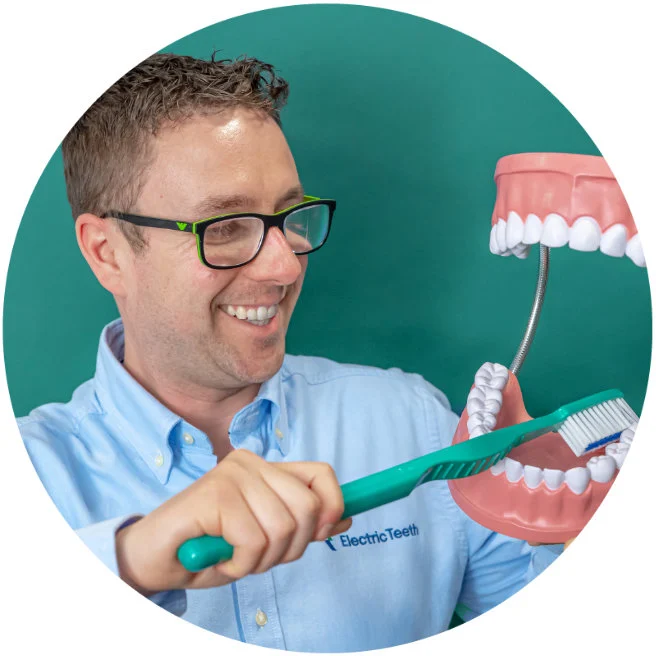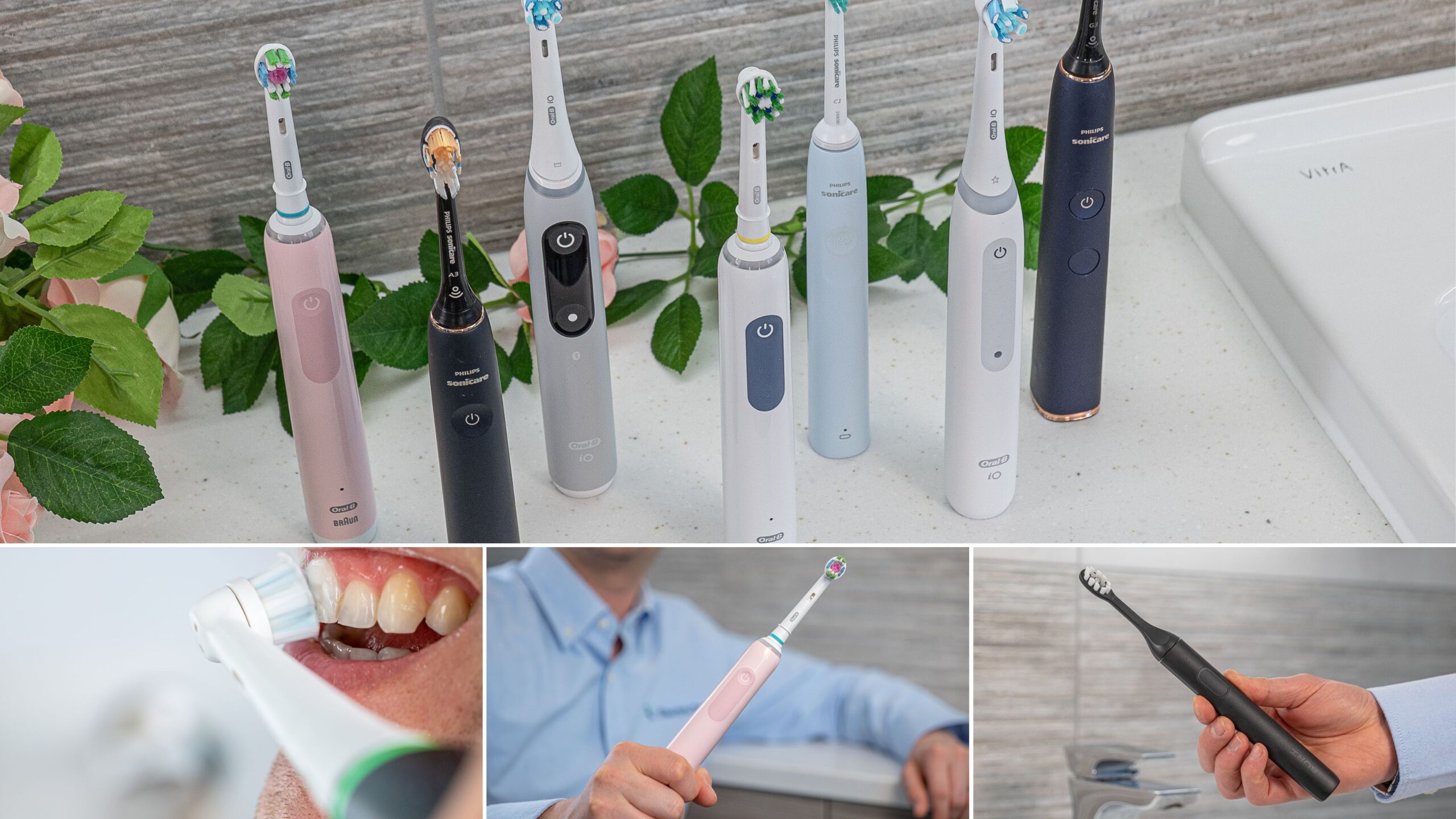
How we tested
We specialise in reviewing dental health products and we’ve been consistently testing them since Electric Teeth launched 8 years ago.
When a new brush is released, we buy it, test it and compare it to what’s already available. We then update our reviews and recommendations accordingly. We publish in-depth written and video reviews to share our findings and opinions.
We’ve included the most relevant details below, but we go into more depth in our detailed hands-on reviews. To make our recommendations, we test and consider the features that dentists recommend as the most important: a pressure sensor, timer and pacer.
But we also take into account the finer details like how easy it is to keep a brush clean, how difficult the heads are to pull on and off, and whether or not it’s easy to accidentally turn the brush off during use. You can find out more about our testing process here. Not only do we test products ourselves, but we take on feedback from our community. We have open comment sections and a popular YouTube channel.
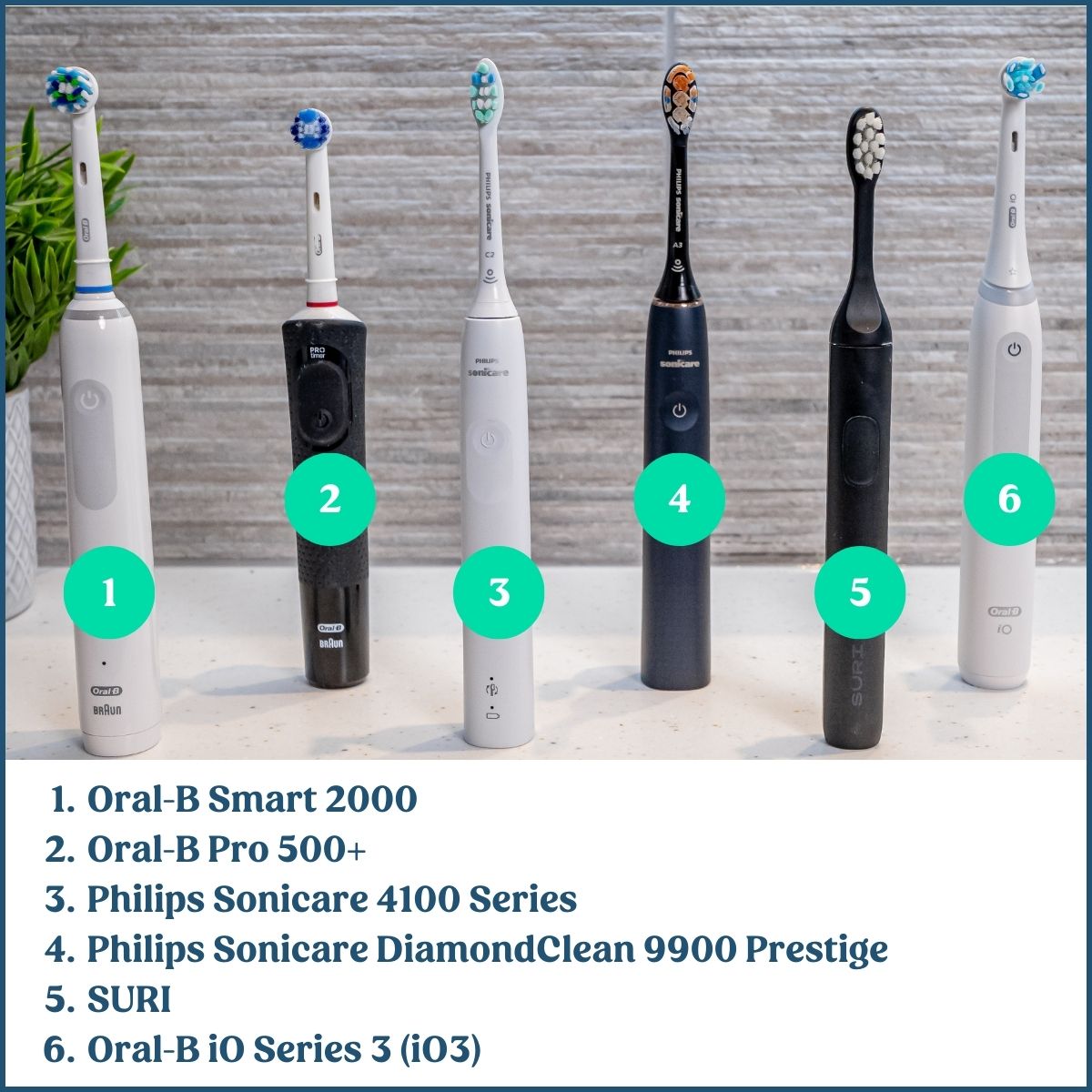
What to look for, what to avoid
We explain these points in more detail later on, but before you make a choice, here are the key things you should know to avoid spending too much or too little.
Keep these in mind as you browse our recommendations below and keep reading for more insights from our testing:
Best overall
The following two brushes, the Smart 2000 and the iO3, are what we regard as the best brushes for the majority of users. They've got the key features, but don't inflate the price with unnecessary extras.
Oral-B Smart 2000

Cleaning modes: 3 | Battery life: 14+ days | Bluetooth: No | Noise: 75dB | Head cost: $8 | Cost to own - 3 yrs: $168
Who it's for:
Someone who wants a reliable brush with dentist-recommended features (a timer, a pacer and a pressure sensor) for a fair price.
Why it's our main choice:
It has the essential features you need and not lots of unnecessary extras. Replacement brush heads are affordable, too.
We love the cleaning results the Smart 2000 gives. After each brushing session, our teeth felt like they had just had a scale and polish at the dentist.
More on why we chose it...
We’ve found that because the toothbrush doesn’t turn off automatically, we often brush for a bit longer than the recommended 2 minutes.
Having tested many brushes, we know that all will, over time, be left with toothpaste residue and gunk on the head and handle. The Smart 2000 is one of the easiest brushes to keep clean — a quick rinse or wipe is all you need. The lack of rubber grips helps here, but the downside is that it’s not as grippy as some other handles, particularly when wet. Unless you struggle to hold things this isn't a problem.
We like the fact the 2000 offers a sensitive cleaning mode. We didn’t always need it, but for those times we did, it was a delight. It’s also a great mode for easing yourself into the increased power of an electric brush.
It’s slightly annoying that there are no labels on the handle to show which mode you have selected. It always defaults to Daily Clean. If you want the sensitive mode you need to press the power button twice, every time you use it.
At 75 decibels it's one of the louder brushes we’ve tested, although typical for Oral-B. If you’re brushing whilst someone sleeps, you’ll want to shut the door. The vast majority of brushes operate at 60-70dB. Unless you need a very quiet brush (see our recommendations below), this isn’t a big issue.
Despite being called ‘Smart' 2000 there is no Bluetooth connectivity, and therefore is not a ‘smart’ toothbrush as the name may suggest.
Read our Oral-B Smart 2000 Review.
What we like |
Worth noting |
|---|---|

Easy to keep clean |
No cleaning mode icons/labels |

Small round brush head cleans the teeth well |
Defaults to the daily clean mode |

Dentist recommended features |
Despite the name, it is not a ‘smart’ toothbrush |
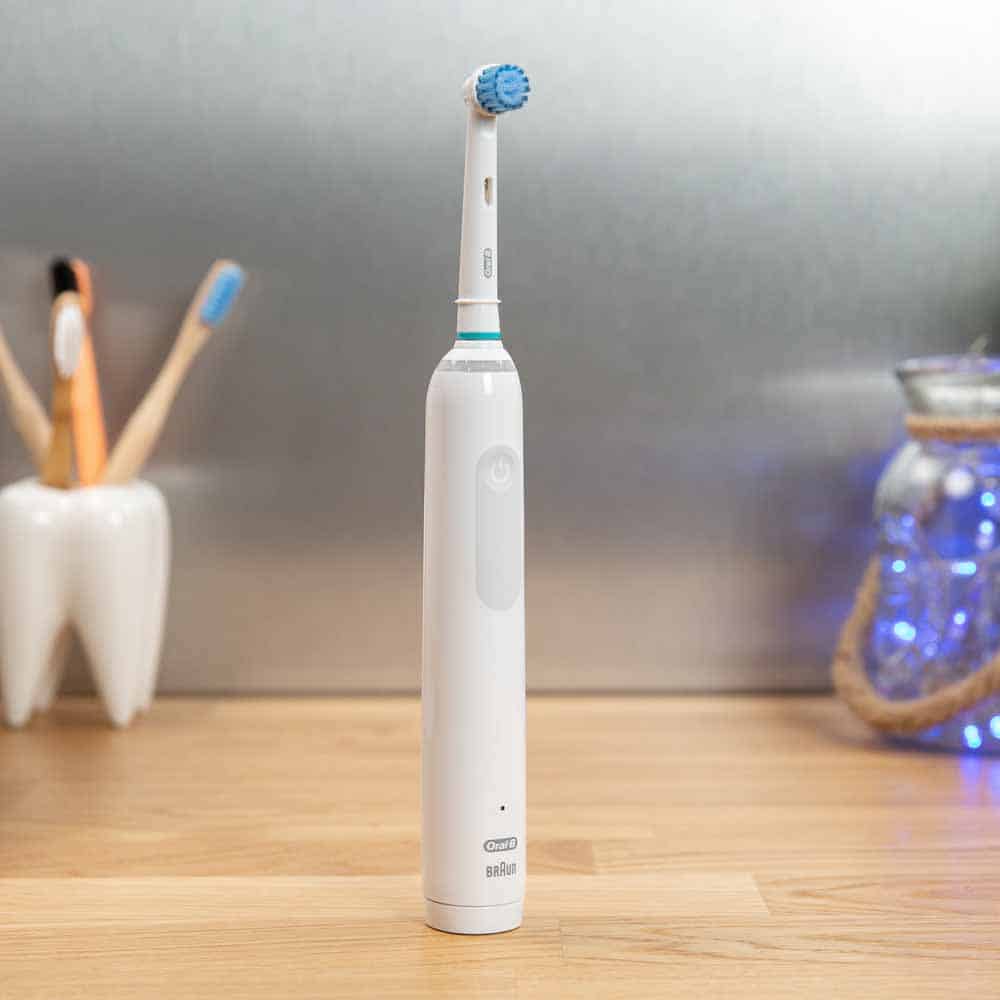
Runner up
Oral-B iO3

Cleaning modes: 3 | Battery life: 14 days | Bluetooth: No | Noise: 64dB | Head cost: $15 | Cost to own - 3 yrs: $245
Who it's for:
Someone who wants a good value brush with an advanced pressure sensor
Why we picked it:
It offers a quieter and softer brushing experience than the Smart 2000. The pressure sensor is also more useful.
The iO3 is similar to the Smart 1500 and is often cheaper, but its replacement brush heads are twice as expensive, making it more costly long term. Both are great, but the Smart 2000 is better value for money.
More on why we recommend it...
Exclusive to the iO Series is an advanced pressure sensor. We particularly like how it shows with a green light when you’re applying the correct pressure, rather than just showing a red LED when you brush too hard. The iO is the only range that has a pressure sensor like this.
Whilst we don’t quite agree, we understand the sentiment when readers say the Smart 2000 feels like a jackhammer in the mouth. The iO3 feels quite a bit different in that respect; it’s far less aggressive and we found it noticeably softer on the teeth when brushing. If you’ve got gum recession or tooth sensitivity, the iO3 is a good choice.
It’s noticeable how much quieter the iO3 is compared to the Smart 2000 — 64 decibels compared to 78. It’s less mechanical sounding, which is more pleasant. The matt finish to the iO3 handle creates a smarter looking brush than the gloss plastic found on many other Oral-B models.
Letting the iO range down is the cost of replacement brush heads. Although the iO3 is the cheapest model in the range, it still requires iO-specific refills. These are around 2 times the cost of those for non-iO brushes like the Smart 2000. We do prefer the feel of iO brush heads, but if you’re on a budget the difference isn’t worth stretching for.
What we like |
Worth noting |
|---|---|

Premium looking handle that is easy to keep clean |
No icons on the handle to show which cleaning mode is selected |

Quieter than other Oral-B brushes |
Requires iO specific heads which are more expensive |

Reminds you when to replace the brush head |
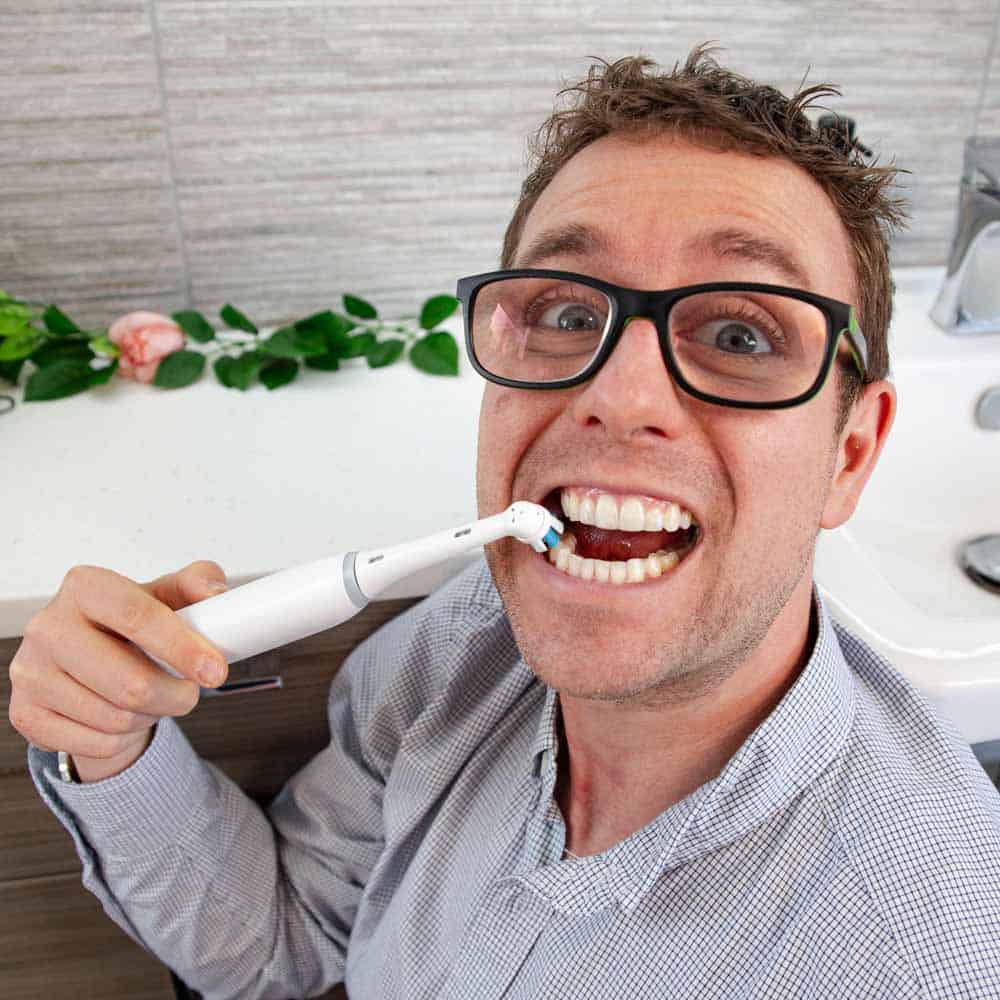
Most environmentally-considerate
SURI
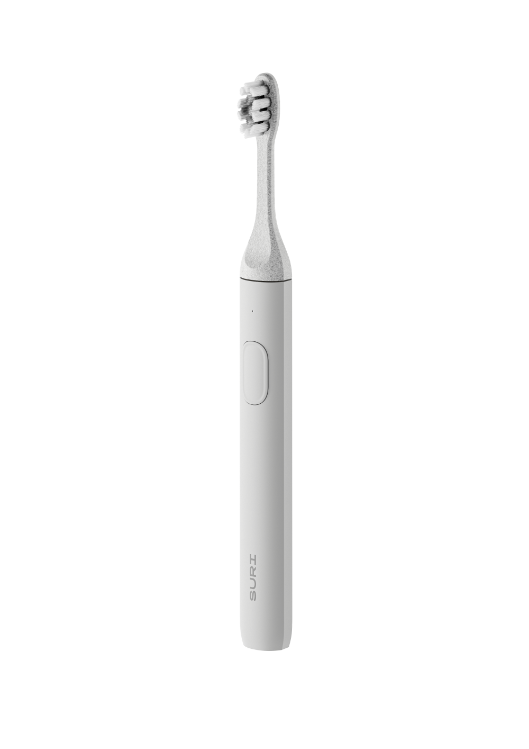
Cleaning modes: 2 | Battery life: 40 days | Bluetooth: No | Noise: 54dB | Head cost: $8 | Cost to own - 3 yrs: $224
Who it's for:
Someone who’s willing to pay a bit more for a good quality brush that considers the planet
Why we like it:
Our team has been thoroughly impressed by the quality, travel-friendly design, cleaning results and company ethos of SURI — several have made it their daily toothbrush since its original testing in 2022.
More on why it's good...
Unlike most other brushes SURI’s handle is made of metal, which gives it a premium look and feel. We find its weight and shape balance nicely in our hands and give it a solid, well-built quality.
It’s a brush that’s easy to keep clean and doesn’t need charging regularly. We’ve found the cleaning results to be just as good as brushes from major brands.
SURI has made simple design choices that work. The compact travel case feels sturdy and allows the brush to charge in the case. We’ve also enjoyed reduced clutter in the bathroom thanks to the effortlessly simple magnetic wall mount.
The main downside is that SURI doesn’t come with a pressure sensor. As experienced toothbrush users, this wasn’t a problem for us. But if you’re a first time toothbrush user or if you know you brush too hard, this may not be the brush for you.
The brush heads can also be a bit stiff to pull off, which you need to do every so often to rinse the brush thoroughly. This is only likely to be a problem if you’ve got dexterity issues or have trouble gripping things tightly.
For many, the main appeal of SURI will be its better focus on environmental impact than its competitors. It’s designed to be easily repaired, albeit by SURI rather than the user.
What we like |
Worth noting |
|---|---|

Environmentally considerate materials and design |
No pressure sensor to alert you when brushing too hard |

Slim handle |
1 year warranty |

The timer and pacer encourage brushing for the recommended time |
USB charger makes it less convenient for some |
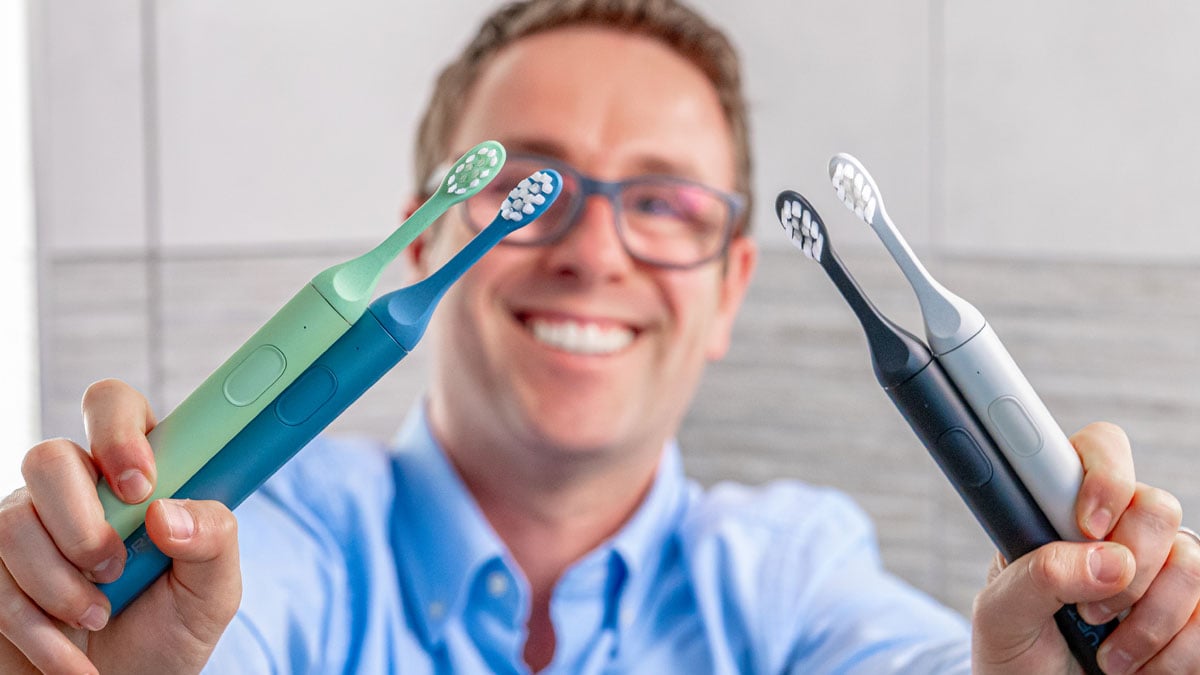
Best technology
Sonicare 9900 Prestige

Cleaning modes: 5 | Battery life: 14 days | Bluetooth: Yes | Noise: 71dB | Head cost: $13 | Cost to own - 3 yrs: $543
Who it's for:
Someone who wants the very best and doesn’t mind paying for it.
A fantastic brush, but more than you need:
We love how it looks, how it feels and how it performs. It has certain refinements and extras that you don’t get with more affordable models. It’s the best smart toothbrush we’ve used.
More on why we chose it...
The smooth touch materials are good quality and we found it easy to keep clean.
To address past reliability issues, Philips has implemented a seamless power button design. The intention of this is to reduce grime build up and, from our testing, this seems to have worked. It does mean that the feedback isn’t as tactile — it’s a bit firm — but this wasn’t a big issue for us overall.
To some it might feel a bit overbearing, but the Sonicare app and tracking technology can improve your oral care routine. It shows and logs where you have and haven’t brushed, which really helps if you like to learn visually. It tells you if you’re brushing too hard and it even monitors, alerts and adapts if you move the brush head too much.
During our testing, we didn’t find the smart features to be annoying, but we stopped checking the app for feedback after a while, which defeats the point of having a premium smart brush. Unless you’re dedicated enough to spend the time using it, it’s not worth paying for the extra tech.
Something we did find frustrating was having to use the app to change cleaning mode. Unlike other toothbrushes, you can’t do it using the handle itself. Then again, the extra modes have little benefit in our experience.
The compact USB-C enabled charging case feels robust and we’ve enjoyed its smaller-than-average profile when travelling. The strap on the case is a little impractical — it’s too tight to go over most hands and onto the wrist — but it’s a minor complaint in the scheme of things.
Read our Sonicare Prestige 9900 Review.
What we like |
Worth noting |
|---|---|

Premium look & feel |
Expensive |

Visible pressure sensor alerts you when brushing too hard |
No place to store the detachable USB cable |

Reminds you when to replace your brush head |
Pressure sensitive buttons |

Stylish & compact charging travel case |
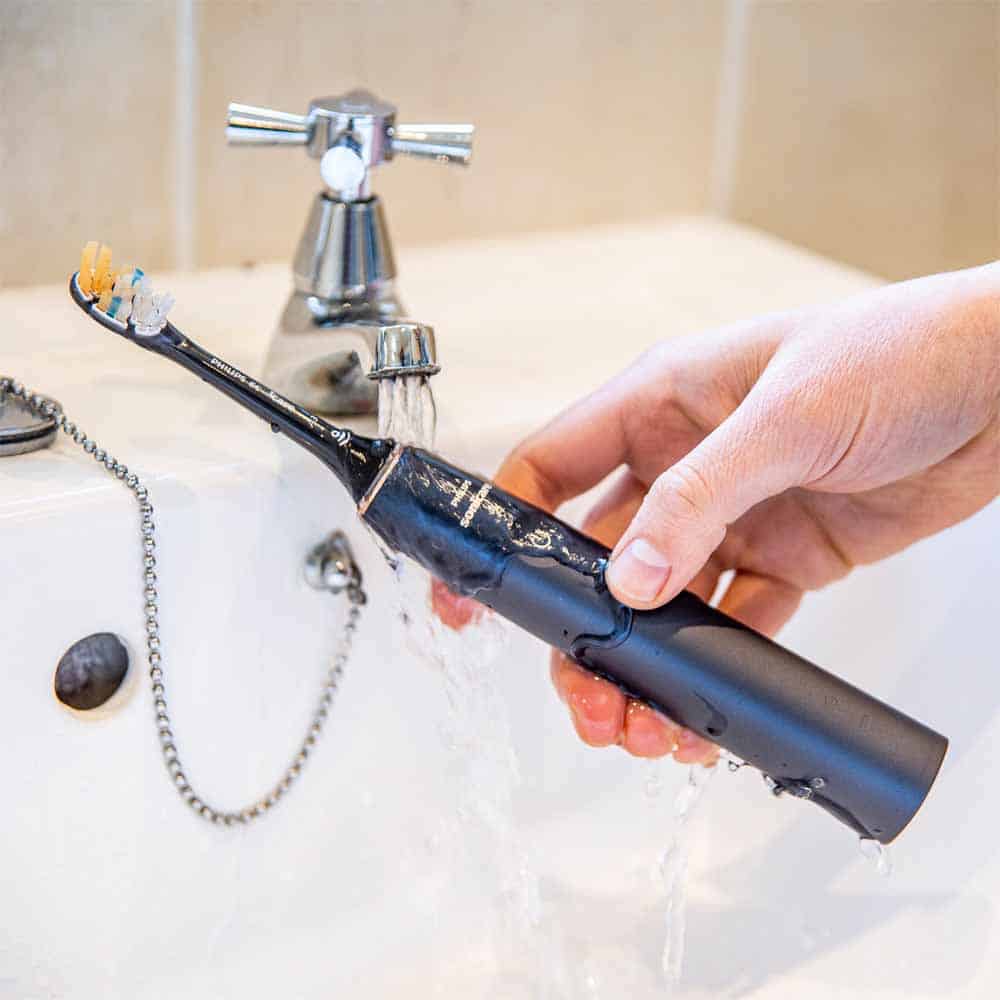
Best for sensitivity
Sonicare 4100 Series

Cleaning modes: 1 | Battery life: 14 days | Bluetooth: No | Noise: 60dB | Head cost: $13 | Cost to own - 3 yrs: $208
Who it's for:
Those who want a gentle but effective clean. See the advice in this section if you've got sensitive teeth or receding gums.
Why it's good for sensitive teeth and gums:
We like the slim profile, the less intense brushing sensation and the opportunity to buy it with a travel case.
More on why we chose it...
The 4100 Series offers a low and high power setting. Both intensities feel less harsh on the teeth and gums than the oscillating-rotating action of Oral-B models. Importantly, we haven’t found this to have a negative impact on cleaning results.
A Clinical study has found evidence that Sonicare’s sonic cleaning action can deliver better results long term than an Oral-B brush, particularly for more advanced gum disease.
If your sensitivity was caused by brushing too hard, the pressure sensor in the 4100 will alert you if you fall back into old habits.
The fact that the 4100 alerts you when it's time to replace the brush head is quite handy. The notification isn’t too annoying and you’re not prevented from using the head for longer if you want to.
When you do replace it, the 4100 detects the new head automatically. There’s no need to reset the tracking facility, like there is with app-based brush head trackers on some other brushes. It’s an effortless process. The only thing we don’t like is that more e-waste is created each time you use a head.
Managing tooth sensitivity can require brushing at times you wouldn’t normally — after lunch, for example. Having the option of buying the 4100 with a travel case is useful as the basic but functional plastic case makes it easier to take your brush with you. It’s typically a few pounds more expensive and worth investing in.
Read our Sonicare 4100 Series review.
What we like |
Worth noting |
|---|---|

Slim, stylish & easy to keep clean |
No indicator lights to show which intensity is selected |

2 intensity settings – choose between low and high power |
USB charger makes it less convenient for some |

Reminds you when to replace your brush head |
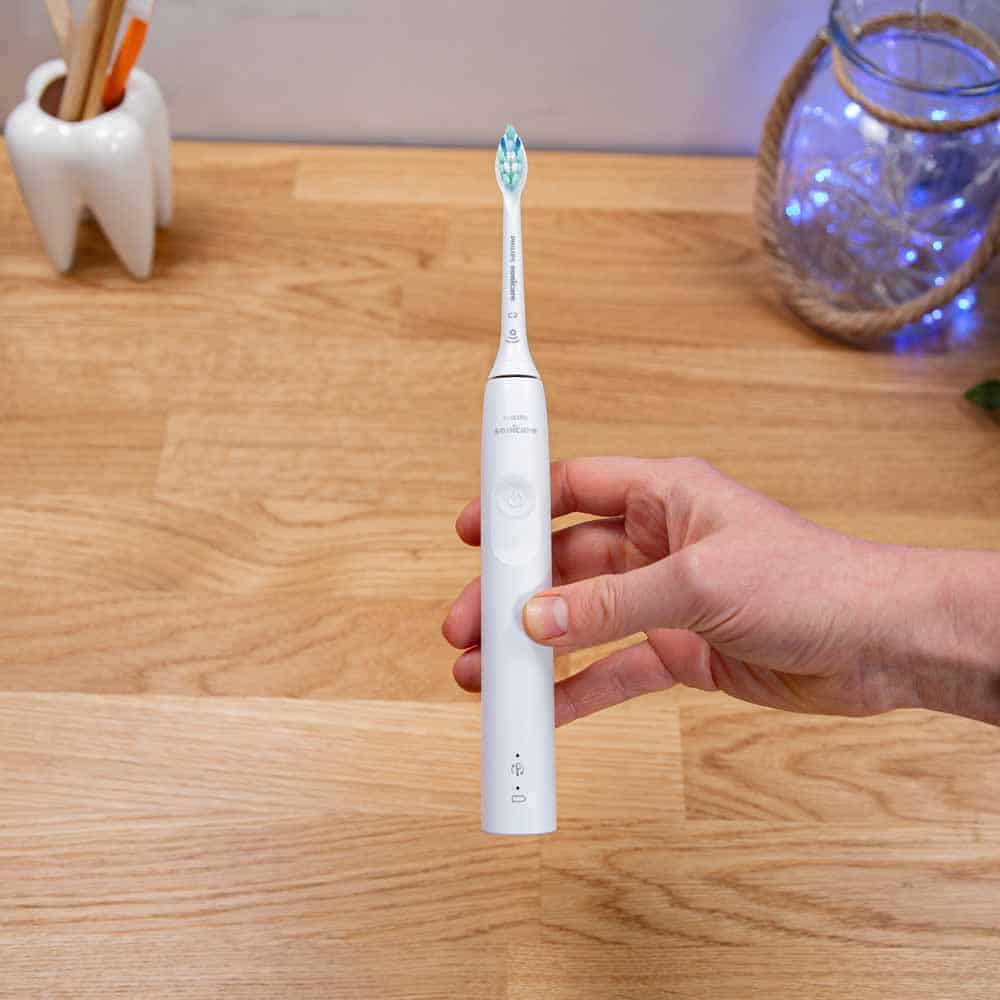
Best budget
Oral-B Pro 500+

Cleaning modes: 3 | Battery life: 10 days | Bluetooth: No | Noise: 73dB | Head cost: $8 | Cost to own - 3 yrs: $125
Who it's for:
Someone who wants a reliable brush for as little money as possible.
Cheap, but still reliable:
We love that for a fair price you get a really grippy handle that delivers perfectly adequate cleaning results. Impressively, the 500+ doesn’t look or feel cheap — the reduced cost comes from excluding some features.
More on why we chose it...
The Pro 500+ would suit a lot of different users, but from our testing, those with arthritis or dexterity issues come to mind in particular. The large rubber grip wraps around the whole handle and doesn't feel slippery, even when wet. The tapered design is a bit thicker than most brush handles, which helps if you can’t form a tight grip.
A slight negative is that toothpaste residue and grime can collect on the dimpled surface, but it’s a worthwhile tradeoff. The 500+ does not include a pressure sensor, but that is understandable at this price point.
Another downside is that there is nothing to indicate battery status. The Pro 500+ has one of the shortest usage times of a rechargeable toothbrush, so it would be useful to get a warning when it needs a top-up. Unless you charge it after most brushing sessions, there is a good chance of it power off mid brushing. Depending on the convenience of your charging set up, this is a worthwhile trade off for the cost saving.
Read our Oral-B Pro 500+ review.
What we like |
Worth noting |
|---|---|

Simple to use – 1 cleaning mode |
No pressure sensor |

The grip on the handle helps to securely hold the brush |
No battery status feedback |

The small round brush head reaches tighter spaces |

Best for travel
Philips One by Sonicare

Cleaning modes: 1 | Battery life: 30 days | Bluetooth: No | Noise: 71dB | Head cost: $7.5 | Cost to own - 3 yrs: $138
Who it's for:
Those looking to travel extremely light, particularly backpackers.
Why it impressed us:
It’s not much bigger than a manual toothbrush and comes with a useful travel case whilst giving a little extra cleaning power.
More on why we chose it...
You will barely notice this toothbrush in your bag. You could even slip it in your pocket if you so desired.
We prefer the rechargeable variant over the AA battery option — you get the same good battery life, but you also get feedback on the remaining power via an LED.
Because it uses a USB Type-C connector, you can probably use the same cable to charge your phone and your brush.
The One is a crossover between a manual and electric brush and we did find the cleaning action to be a bit weak as a result, but we found that plaque removal was still good if we made sure to use the correct technique. It doesn’t feel as thorough as other electric toothbrushes, but that’s the trade off for a slim, lightweight brush. If you’re looking to use it as your main brush, you may be disappointed if you’ve had a more powerful brush in the past.
The travel case has been designed to be as small as possible, but we found that it still offers adequate protection of the bristles and power button.
Read our Philips One Review.
What we like |
Worth noting |
|---|---|

Slim, light and grippy in hand |
The cleaning power is a little weak |

A travel case is included |
No pressure sensor |
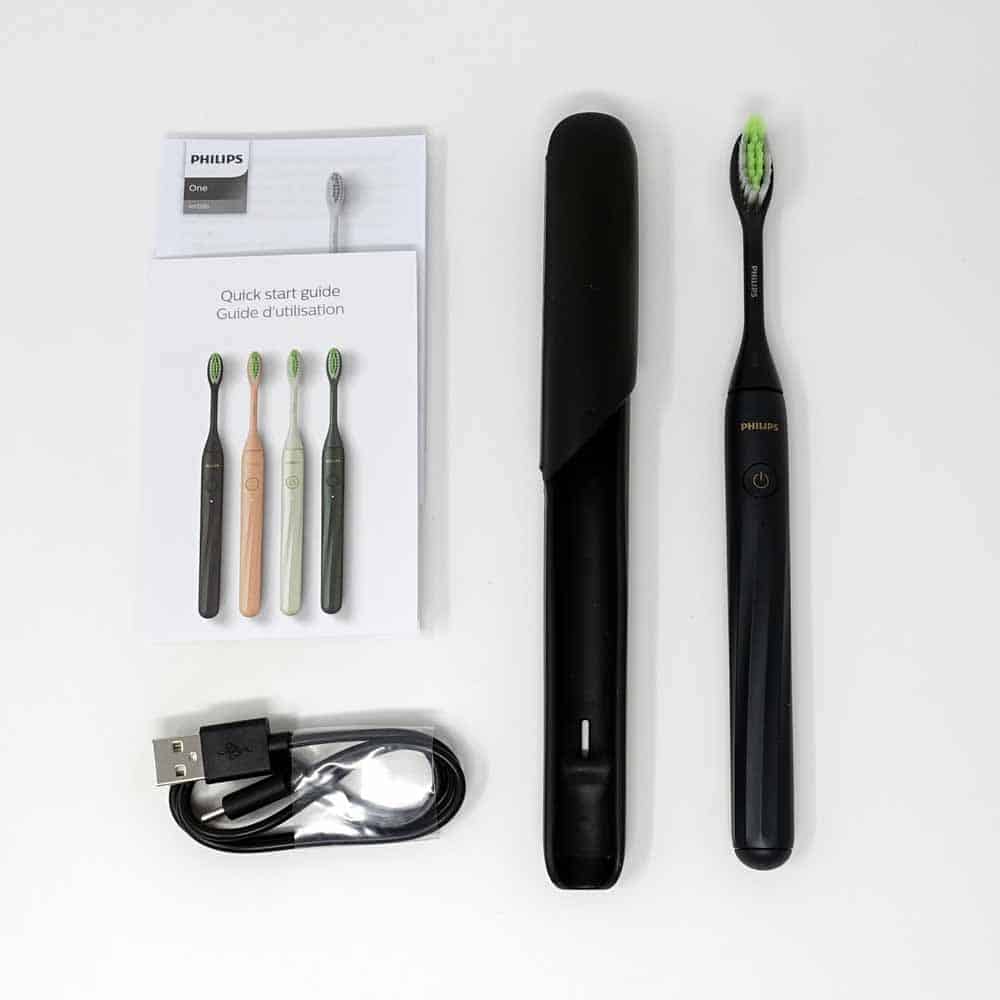
Quietest
Oclean X Pro Elite

Cleaning modes: 4 | Battery life: 35 days | Bluetooth: Yes | Noise: 45dB | Head cost: $8.5 | Cost to own - 3 yrs: $194
Who it's for:
Those who want an almost silent tooth brushing experience.
Quiet, without compromise:
It’s the quietest brush we’ve tested and makes no compromises to achieve it.
More on why we chose it...
The X Pro Elite doesn’t look or perform differently to any other regular electric toothbrush, yet it is 15-25 decibels quieter than bigger brands like Oral-B and Sonicare.
You do pay a slight premium, but it’s well within the lower mid-tier price range and you actually get valuable extras.
The X Pro Elite comes with 4 cleaning modes and 32 different intensity settings, which is overkill in our experience. We tended to use it on the maximum setting, which was comparable to Sonicare. We can’t imagine a need for such granular control over intensity, but if you suffer from sensitivity it might be useful.
A timer and pacer are included. There is a pressure sensor, but it’s not visual, nor does it vibrate. It does slow the motor to limit the damage though. We didn’t find it to be as good as pressure sensors from Oral-B and Sonicare, but if you want the quietest brush possible, it’s something that can be overlooked.
If you have a small bathroom and limited countertop space the magnetic wall mount really helps. 1 month of usable battery life meant that we only needed to get the USB charging stand out once a month during testing. It doesn’t need a permanent home on the worktop.
We liked how it tracks in real-time to give feedback on brushing via the touchscreen display. It’s far from perfect, but better than nothing. It’s great to get this without a silly price hike to pay for it.
What we like |
Worth noting |
|---|---|

Stylish handle with colour touchscreen display |
Bluetooth & smartphone app – Doesn’t work in real-time |

The grip on the handle helps to securely hold the brush |
Can’t be charged whilst mounted on the wall holder |

Easy to use magnetic wall mounted holder |
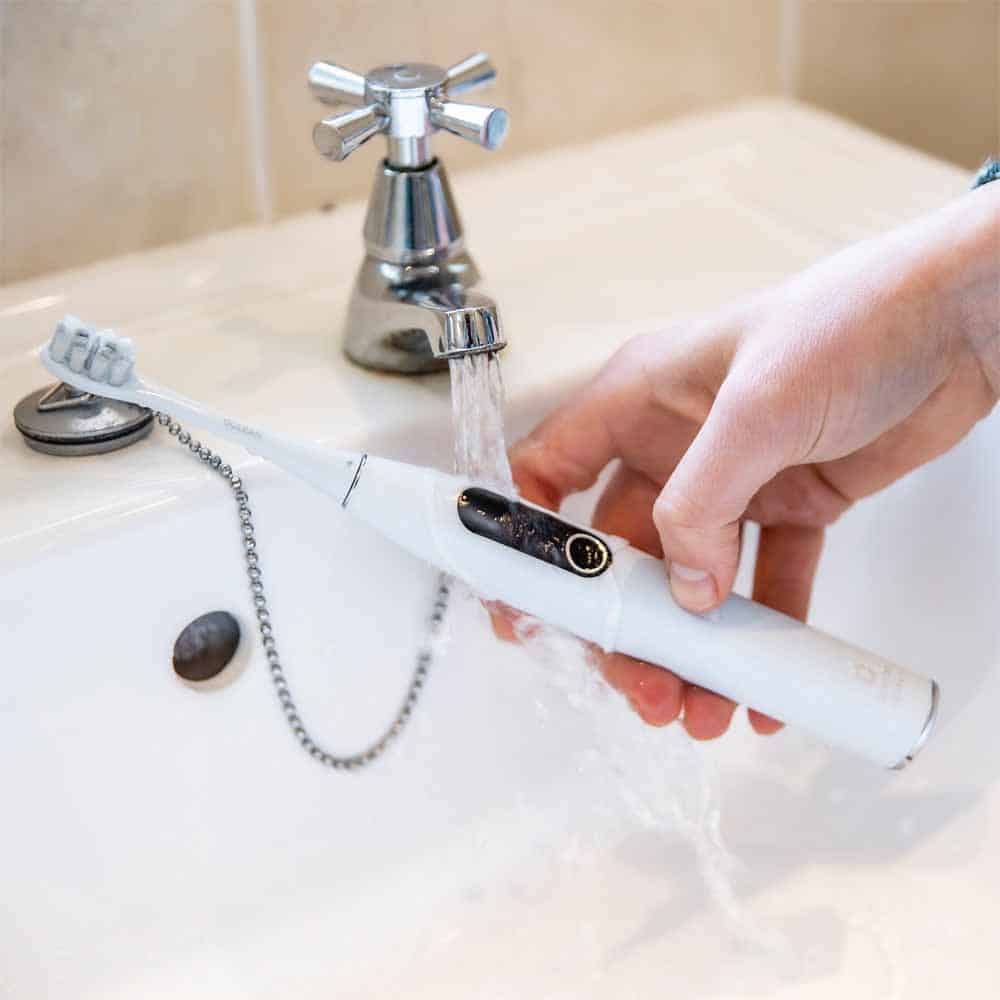
Best removable battery
Oral-B Pro 100

Cleaning modes: 1 | Battery life: 90 days | Bluetooth: No | Noise: 71dB | Head cost: $8 | Cost to own - 3 yrs: $108
Who it's for:
Someone who doesn’t want to plug their toothbrush in to recharge.
Why we picked it:
It gives 3+ months of battery life, it’s grippy, easy to use and affordable.
More on why we chose it...
You can’t fault the ease of use of the Pro 100. It’s one of the most textured and grippy handles we’ve used. It’s got a shorter and wider profile than most brushes.
We found cleaning results to be perfectly adequate. You can get better results from other brushes, but as long as you use it correctly it’s not a night and day difference.
We enjoyed the simplicity of only having 1 cleaning mode to choose from. Other than a sensitive mode, the additional cleaning modes that other brushes have aren’t really necessary.
Given it costs less than a week's worth of coffee, it lacks all the other bells and whistles of other electric brushes.
It’s a cheap long term option because it uses Oral-B’s standard brush heads which are half the price of iO heads or those from other brands.
Replacing the 2 x AA batteries can add to the ownership cost, but you do have the option of using rechargeable AA’s. Replacing them can be quite tricky — the cap doesn’t glide on and off as well as we would like — but a quick fix is a bit of oil on the rubber o-ring.
Watch our Oral-B Pro 100 review.
What we like |
Worth noting |
|---|---|

1 cleaning mode that’s easy to use |
No timer, pacer or pressure sensor |

The grip on the handle helps to securely hold the brush |
No battery status feedback |
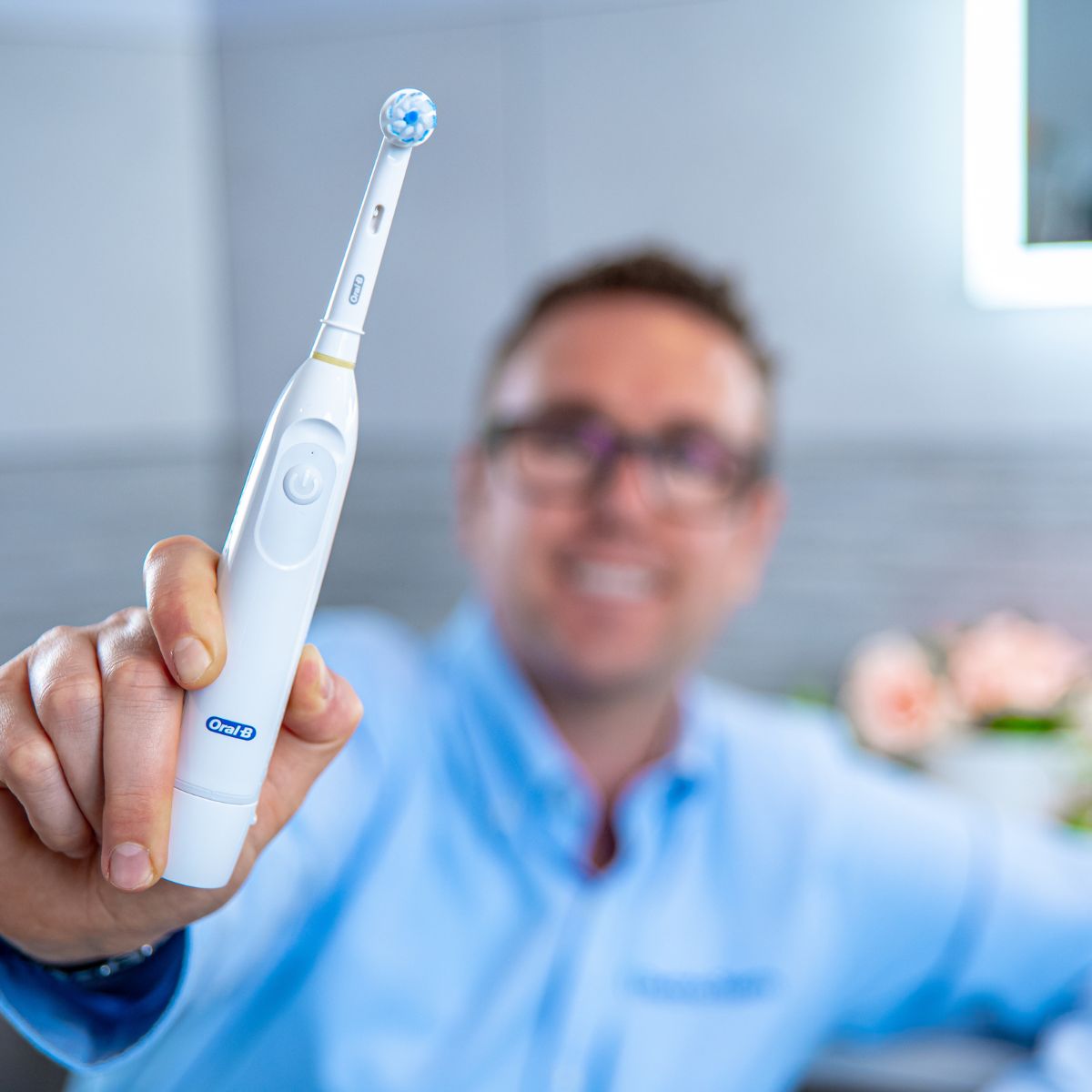
Notable mentions
These are products that didn't quite make it into our list above, but have features that may find useful in specific cases.
Oral-B Pro 1000
It sits between our best overall and best budget recommendations.
We found the cleaning results to be better than the budget Pro 500+, but we missed the visible pressure sensor of the Smart 2000.
A pressure sensor is important if you have a habit of brushing too hard, but if you already know you don’t brush too hard (perhaps you've had a brush with a pressure sensor in the past) this is an excellent choice. It strikes a balance between features and price.
For more information, see our Oral-B Pro 1000 review.

Curaprox Hydrosonic Pro
The small teardrop brush heads with soft bristles are an absolute delight to use. We found it much easier to reach the tighter spaces in the mouth with these heads compared to most other sonic brushes. The silicone backed heads helped to prevent that cold and harsher feel on the teeth and gums.
The handle is unique in that it has flat sides and we noticed how it encouraged us to tilt the brush at the correct angle.
It looks and feels great, but is a bit pricey given the other choices available.

Recently tested
We are always testing new brushes from a variety of brands and of varying prices to ensure our recommendations are up to date.
The R2 and D2 from Bitvae are budget-friendly options that are closely matched for features to the Oral-B Smart 2000. It’s hard to quibble with what you get for the price — they are quite a bit cheaper. Although it doesn’t impact daily use, material quality is one compromise — we could feel the difference. Subsequently, long term reliability is a concern. As a newer brand, Bitvae is yet to prove itself.
The Silk’n Toothwave brush has DentalRF technology but we couldn’t feel it working, nor could we see or notice any meaningful results. It has some clinical backing, but that’s been paid for by the manufacturer. This shows it is potentially a less abrasive way to achieve deeper cleaning, much like an ultrasonic toothbrush. More study is ideally needed to say if it really works. Pricing and availability for this brush are mixed. We’re not yet sold on it.
We’ve been really surprised by the power and performance of the very compact and travel-friendly Sonisk Pulse, which is powered by removable batteries. Whilst we considered it as a contender for best travel toothbrush, the material quality isn’t the best and we didn’t get the same feeling of durability as you do with the Philips One.
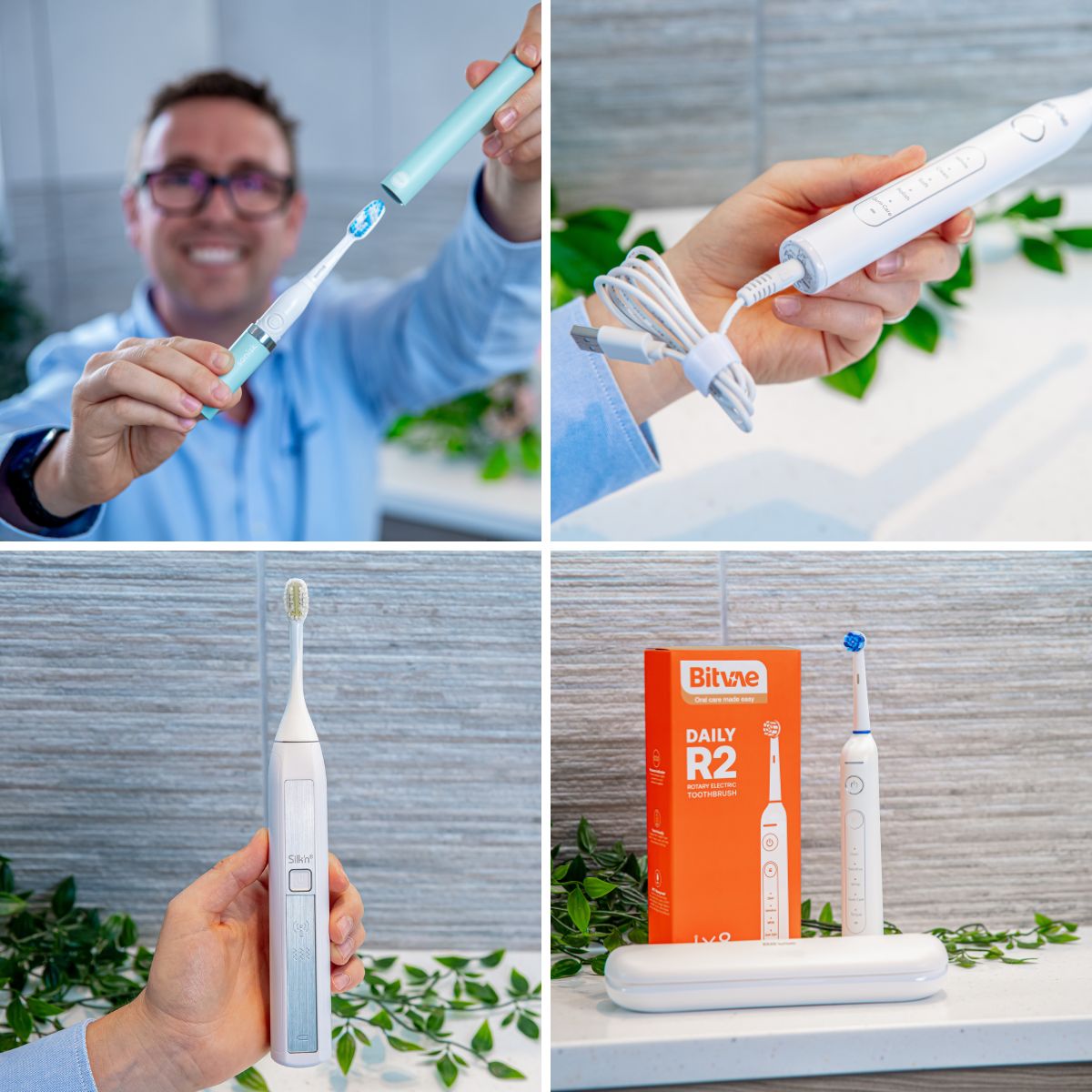
Buyer's guide: useful tips from years of toothbrush testing
In the following sections we've included things we've picked up from reviewing the full spectrum of electric toothbrushes over the last decade.
We cover the features we think are the most important to pay for, as well as others that are worth considering but not critical for the majority of users. We also give some advice on how much to spend.
Key considerations
A pressure sensor, a timer and a pacer are the features worth paying for
These three features help to make sure you brush correctly and for the right amount of time. Generally, you can get a good brush with these features for around $60-100. They are particularly useful if you're a first time toothbrush user, or if you know you brush your teeth too hard.
We have a post that looks at electric toothbrushes with pressure sensors in more detail, but below we have included an overview of why they're important, and here are our main recommendations at a glance:
Good value for money, visible pressure sensor: Oral-B Smart 2000 / Amazon / ~$89.97
Most advanced pressure sensor: iO range (iO3 is the cheapest) / Amazon, Walmart / ~$97.26
Good value for money, vibrating pressure sensor: Sonicare 4100 Series / Amazon, Walmart / ~$59.93
How pressure sensors vary (and why they’re important)
Brushing too hard can damage your teeth and gums. A pressure sensor helps prevent this. Consequently, it's a key feature recommended by our in-house dentists.
If you know that you brush too hard, or if you’ve never used a toothbrush with a pressure sensor, it’s a feature worth strong consideration.
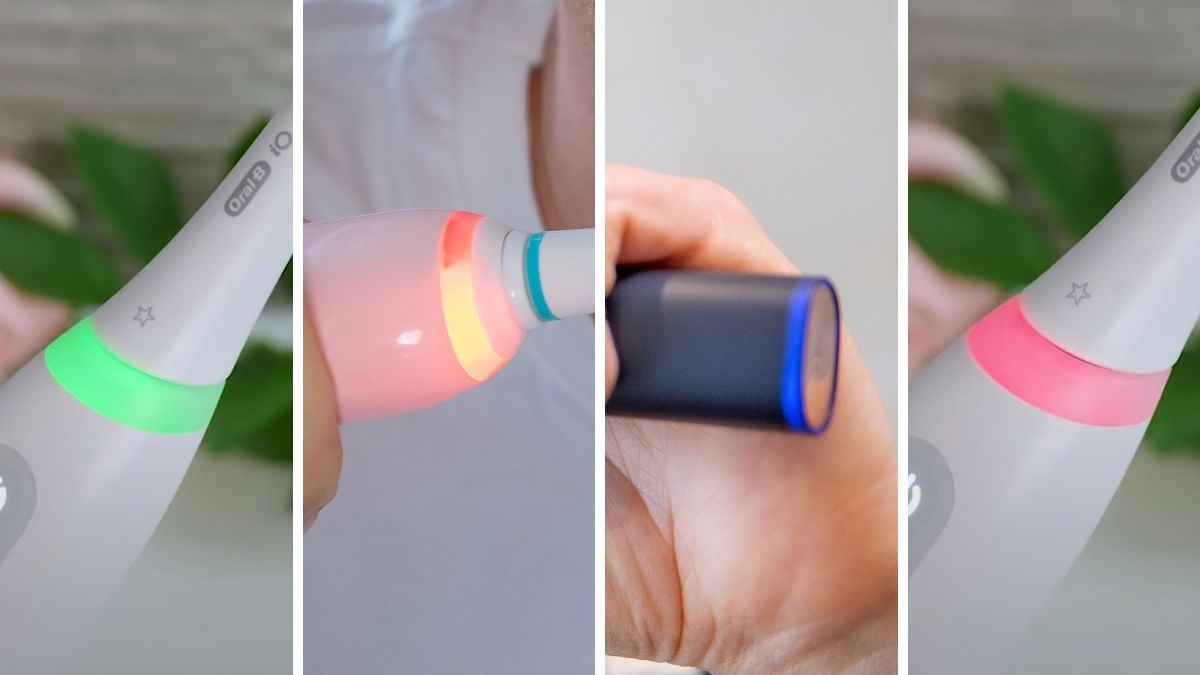
Keep reading
Sensors are implemented differently. In many instances when pressure is detected, the motor will slow down until the pressure is relieved. This limits the bristle movement and potential damage.
A visible pressure sensor will illuminate to act as a visual alert. This is common in Oral-B brushes. Normally, a red light illuminates around the neck of the toothbrush.
Some models, notably Sonicare, will vibrate the brush handle to alert you.
If you tend to brush your teeth in front of a mirror, you will likely find the visible pressure sensor (one that lights up when you apply too much pressure) easier to take note of.
However, if you tend to get a bit distracted as you brush, don’t brush in front of a mirror or are visually impaired, the beeping or vibration patterns generated by some pressure sensors (notably Sonicare) are better.
With the exception of the Sonicare DiamondClean 9900 Prestige, most brushes do one or the other, not both.
The Oral-B iO range features a more advanced pressure sensor. It indicates when you’re brushing too hard, but also when you are applying the correct or insufficient amount of pressure. We did find this to be reassuring, but it’s something you could skip if you’re on a tight budget. The main thing is that you don’t brush too hard.
Most brushes have a timer and a pacer
For 2 minutes twice a day is how long you should spend brushing your teeth according to the likes of the Canadian Dental Association and the World Dental Federation. It’s the optimum time for effective plaque removal.
A timer lets you know when you’ve brushed for this long, whilst a pacer encourages even brushing of the teeth.
All of the brushes we've recommended above have a timer and pacer included. The only exceptions are the Pro Battery which has no timer or pacer, and the Vitality which has a timer but no pacer.
These are features that are really useful and we've found that the way they work tends not to vary much from one product to another. Don’t worry too much about these when choosing a brush. The main thing is to make sure your brush does include them, if your budget can stretch that far. There can be some nuance to them, which we explain in the toggle sections below.
Find out more about timers
The vast majority of brushes automatically turn off after 2 minutes. This might be annoying if you're someone who likes to brush for longer than that.
Oral-B brushes don’t tend to turn off, that’s for you to do when you’re ready to finish brushing. It will pause briefly 3 times at 2 minutes to alert you that the recommended time has been achieved.
Find out more about pacers
Most pacers work by pausing the brush motor at 30 second intervals. The pause in the sound and motion of the toothbrush is your cue to move from one quadrant of the mouth to another. Some brushes (notably Sonicare) have a pacer set to 20 second intervals. This results in 6 sections of the mouth for you to brush.
We've tested hundreds of different brushes over the years and we've never found the implementation of the pacer to make that much difference to how well we brush.
The bottom line is that a pacer is useful to have, especially as you develop your own rhythm to brushing with an electric toothbrush, but precisely how the pacer is implemented doesn't matter too much.
We’ve heard from some users how they dislike a pacer and prefer to brush at their own pace. Unfortunately, few brushes allow the pacer to be disabled. Some brushes, normally the ‘smart’ ones such as the Oral-B iO and Genius models, offer some customization around timings.
Some brushes are easier than others to keep clean
It’s important to keep your brush clean. The last thing you want is to be putting unwanted bacteria into your mouth.
We’ve found that a quick rinse after each brushing session and then leaving the brush to air dry is typically the best approach. UV lights and sterilizing processes can help but are not essential or as recommended as you might think.
During our long-term testing of brushes, we have found that grime can build up more easily on some than on others — we've included some examples in the next section. If you’re often in a rush when you brush your teeth, it’s a good idea to have a brush that’s simple to clean.
From those we’ve recommended above, the easiest to keep clean are: Oral-B Smart 2000, SURI, Sonicare 4100, 9900 Prestige and Philips One.
Some brushes collect grime easily
We’ve found the Oral-B iO series to be one of the worst offenders for grime build up. That’s not to say it can’t be kept grime free — it can — but it takes more effort than other brushes that just need a quick rinse under the tap.
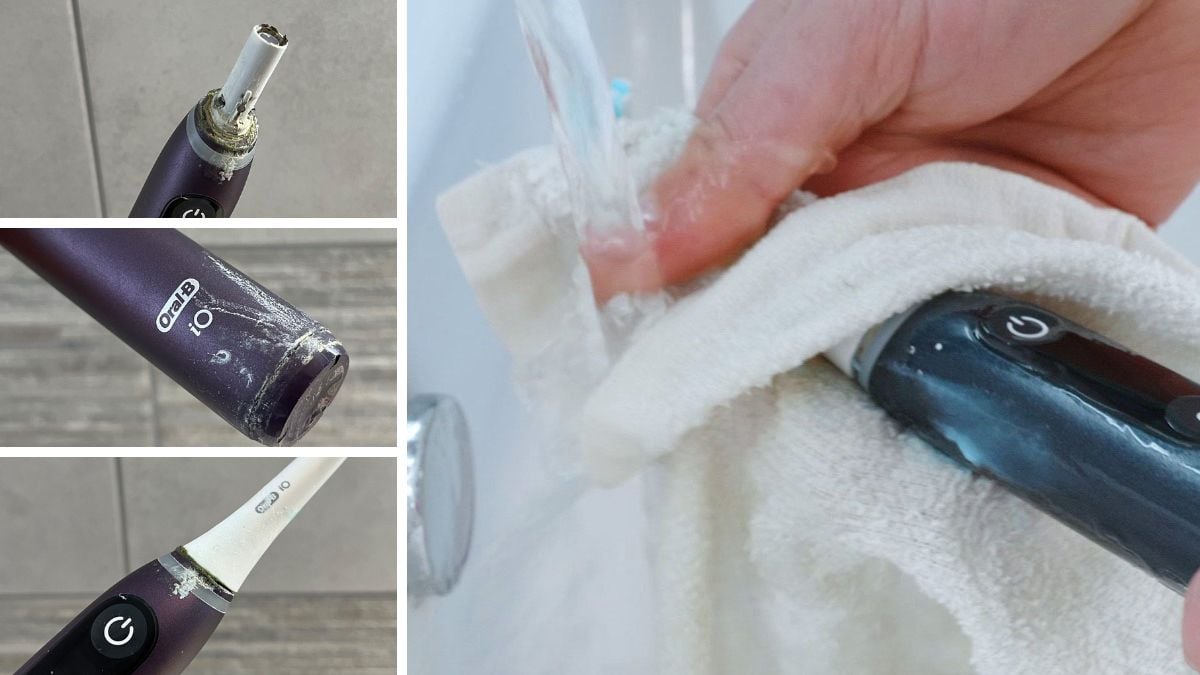
The design of the iO motor and heads makes it easier for muck and mold to build up within the neck where the brush head attaches. Even with thorough rinsing after each clean, we still find that grime tends to build up after a few weeks. We’ve found the most practical way to remove it is with a used interdental brush.
Brushes with large textured rubber grips do tend to be worse for dirt build-up than the smooth, all plastic handles of some brushes — examples here are the Vitality and Genius models from Oral-B. Residual toothpaste and gunk dries to leave white streaks. Cleaning from the textured surface can be much harder, particularly if you don’t keep on top of it. We advise prioritizing grip and comfort over ease of cleaning, though.
Battery life isn’t that important
Unless you are away from mains power frequently, don’t worry about battery life. The majority of rechargeable brushes last 3-4 weeks or longer on a full charge.
We’ve found Oral-B’s battery life to be the worst of the major brands. Expect 2 weeks on average, including from premium models. We’ve seen first hand how iO models with displays can suffer from excessive battery drain and give just 10-12 days use on average.
An overnight charge is sufficient for most brushes, but some can take as much as 24 hours if completely flat.
For most people noise isn’t an important factor, but some brushes are significantly quieter
For each brush we review, we use a decibel meter to take a reading of its noise level. So far we’ve found the range sits from 48 db to over 80 db, which is quite a variation.
Noise may be an important consideration if you’ve got young children that you don’t want to disturb, or light sleepers in the house who won’t appreciate the sound of a noisy motor.
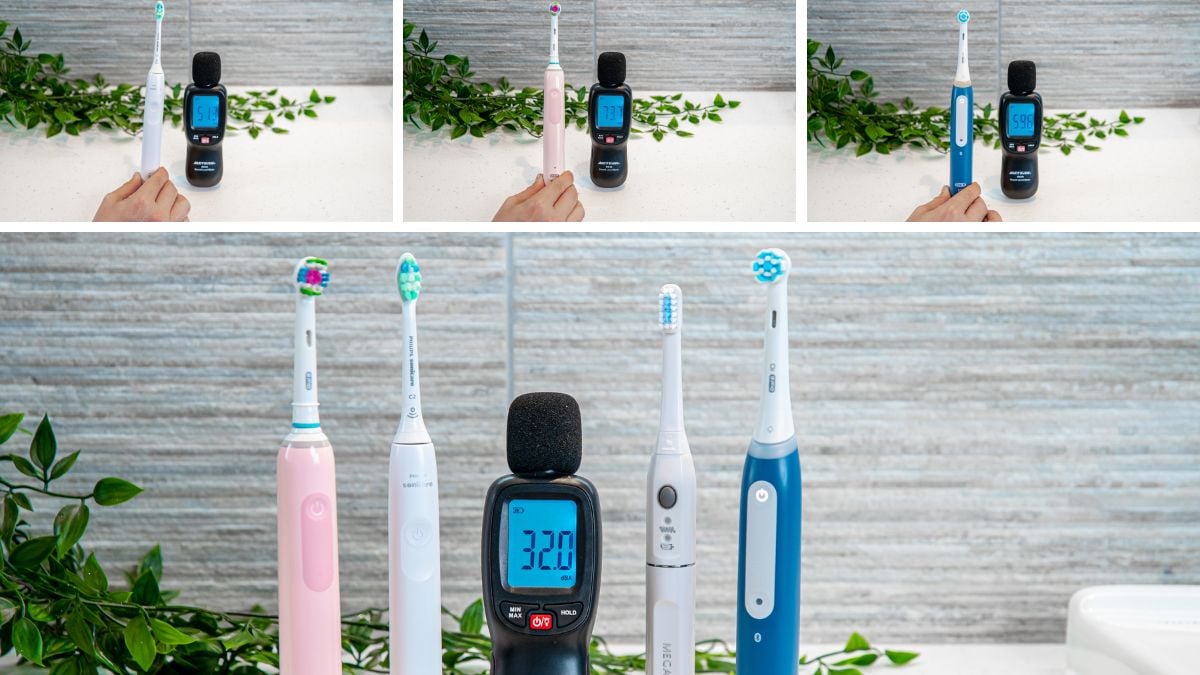
That being said, noise isn’t the biggest consideration for an electric toothbrush. Even with the noisiest brushes, we’ve found that a closed bathroom door drowns out most of the sound. But if you have thin walls or do have a need to be very quiet, it’s a worthwhile consideration.
We’ve got a post on the quietest electric toothbrushes that ranks from quietest to loudest. The winner so far is the Oclean X Pro Elite. From our list above, SURI is also particularly quiet.
You can get a good brush for less than $100 — spending more doesn't mean cleaner or whiter teeth
We’ve tested brushes that cost as little as $20 and as much as $500. Truthfully, you don’t need to spend more than $100 to get a reliable brush with the most important features. Our main recommendation, the Smart 2000, is a good example of this.
The key features our in-house dentists recommend are a pressure sensor, a timer, and a pacer. Generally, you can get these from around $60 to $80. Many of the brushes we’ve tested in this price range are more than adequate.
Spending more money on a toothbrush may provide things like travel cases and better battery life, but these aren’t going to actually help brush your teeth better.
Don’t go too cheap, though
Based on the above advice you may be tempted to spend as little as possible. We would caution against this because we have noticed there are reliability issues with cheap brands.
And whilst you can get by without a pressure sensor, timer and pacer, ideally your brush should include them because they help you to brush properly and for the right amount of time.
If you want a quick reliable recommendation that gets the job done, check out the Oral-B Pro 500+.
We don’t recommend smart toothbrushes for the average user
We’ve been testing smart (Bluetooth enabled) toothbrushes since they first launched around 2016.
Whilst we’ve found that the technology in the latest models like the Oral-B iO Series 10 and the Sonicare Prestige 9900 does work very well, it is overkill for the average user.
We generally don’t recommend them. You don’t need the tech to be able to clean your teeth well — plaque disclosing tablets work just as well — and to get the most from them you often need to have your phone with you when you brush.
A survey of our YouTube audience found that 57% had a smart toothbrush, yet 69% don’t use the features after 3 months.

Apart from the ‘smart’ technology, these brushes often come with additional cleaning modes and a travel case.
In our experience, there is little difference between most cleaning modes. Having a sensitive mode is useful, but this is included with far cheaper brushes.
A travel case can also be a good addition, but again, you don’t need to spend $300 to get one. We rate SURI as having the best travel case and that is far cheaper than a smart toothbrush.
Unless you are willing to spend the time and effort using the brush tracking technology that a smart brush offers, save yourself some money and go for a cheaper model.
Brush head styles aren’t that important, but do affect cost
Brush head ranges are unnecessarily complicated. There is no definitive evidence to say one head is better than another. Studies will claim to have found important differences between them, but this is always in comparison to a manual brush. We’re yet to see 2 Oral-B heads compared to one another in a clinical study.
We’ve tested the full range of brush heads from Oral-B, Sonicare and Colgate and found little to separate them. We’ve also tested generic heads, which are cheaper but still of an acceptable standard.
Sonicare’s premium heads have a silicone backing to them, which feels noticeably softer on the cheeks and reduces that harsh irritating sound if they come into contact with the teeth. But, we find it difficult to justify the price increase when normal heads work just fine.
The main thing you do want to watch out for if you’re buying generic heads is that you don’t get cheap counterfeits as they won’t do as good a job.
Sonic brush heads tend to be larger than the small circular brush heads found on Oral-B’s oscillating-rotating toothbrushes. Sonic heads have an oval shape to them.
We have found that Oral-B’s heads can sometimes make it easier to reach right behind the back molars and other tight spaces because their necks have a shorter length. This isn’t a factor worth giving too much importance to unless you have a particularly small mouth.
As a side note, if you are finding it difficult to reach certain parts of the mouth, it’s better to brush with your mouth almost closed. Having your mouth open extends your jaw and can make it harder to reach certain areas.
The brush you choose will affect how much you spend on brush heads
Pay attention to this because it could save you $100 over the lifetime of your brush.
If you’re buying official heads for a well-known brand, Oral-B heads for non-iO brushes (Vitality, Pro, Genius Series models) tend to be the cheapest.
Oral-B iO brush heads are almost twice the price of other Oral-B heads. The cleaning results are not twice as good. As it stands there aren’t many generic options available as an alternative for iO models. Those that do exist cost considerably less. You can get as many as 6 generic heads for the price of 1 iO Series manufacturer original. Sonicare brush heads tend to be more expensive than Oral-B, but there are good generic options available to bring the price down.
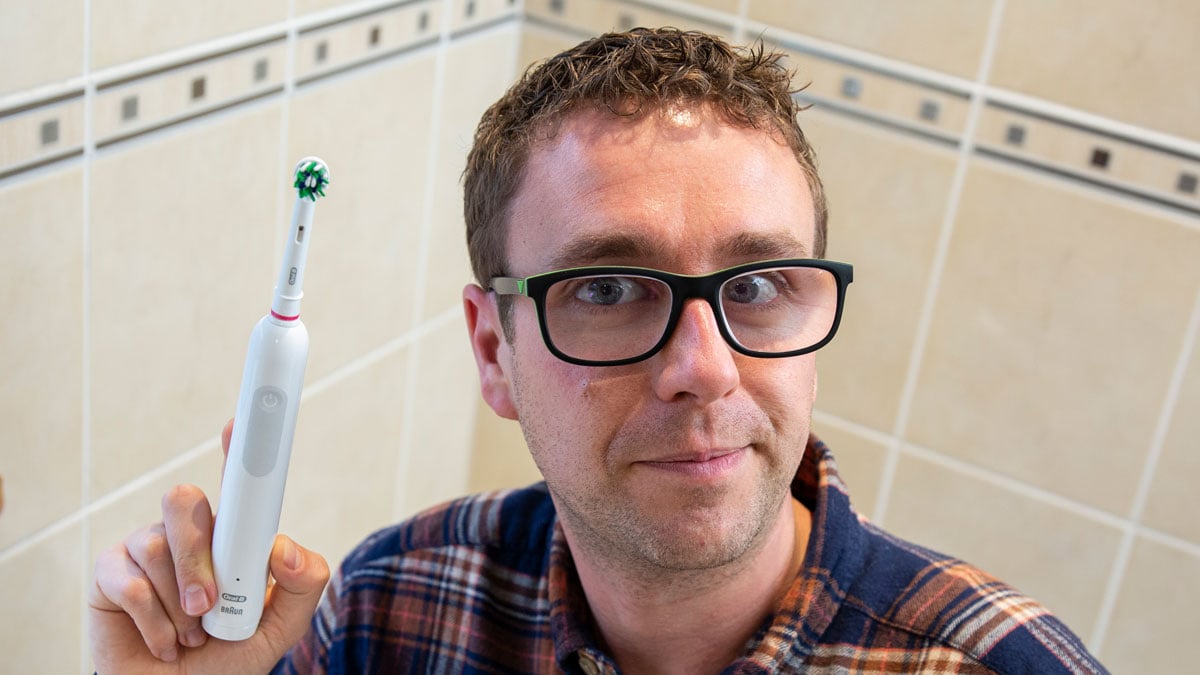
Try to buy heads where the bristle tips are rounded or smoothed off, like the manufacturer’s own. We found that cheaper generic heads often have ‘rough cut’ bristles. They still clean well but can be a bit more abrasive on the teeth and gums.
You can save money if you buy an electric toothbrush and heads from a lesser-known brand, but the caveat to this is reliability issues.
A word of caution though: sometimes there is such a thing as too cheap. We’ve read and heard stories of brush heads cracking, falling apart and bristles falling out as people use them.
Soft brush heads and sensitive cleaning mode are good if you have sensitive teeth or receding gums
Generally speaking, we haven’t found that cleaning modes and brush head styles make much difference to brushing experience. A standard cleaning mode and brush head do the job just fine. The exceptions, though, are soft brush heads and sensitive cleaning modes.
We have at times found it useful to switch to a soft head or cleaning mode during times of tooth or gum sensitivity. If you have sensitive teeth or gums, or some form of gum disease, these are particularly useful features.
Even if you don’t have sensitive teeth and gums, a sensitive cleaning mode or soft brush head can help to ease you into a new brush. This was the case for one of our team when we started testing the Oral-B iO range. The cleaning action of the brush felt more intense than previous Oral-B models, so we used the sensitive mode for the first week or so to get used to it.
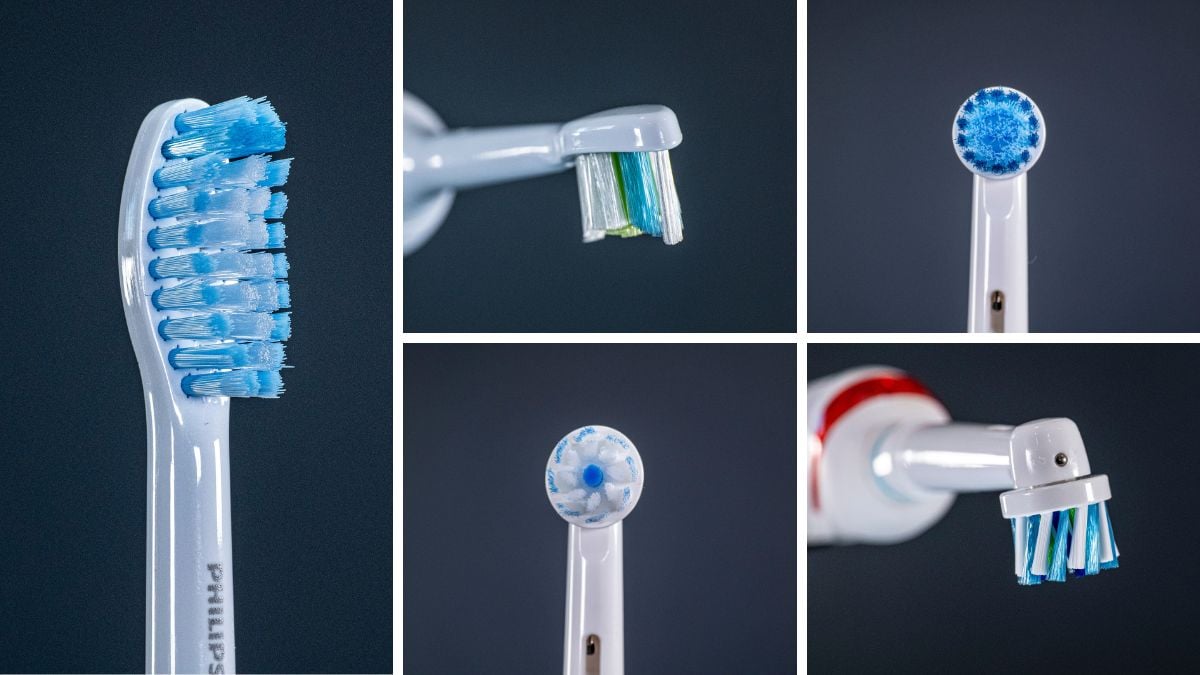
Oral-B and Sonicare both make soft brush heads for their full range of brushes, so this is something that you can add on afterwards if needed. Many brushes do come with a sensitive mode, but you’ll want to double check your prospective brush has it if it’s a feature you think you’ll benefit from. We’ve found the feeling of gentle cleaning modes doesn’t vary much from one manufacturer to another, so you don’t need to scrutinize this too much.
There is some variation in the way that gentle / sensitive modes are named. Some manufacturers instead refer to them as ‘intensity’ settings. A high and a low intensity settings are usually comparable to standard clean and sensitive mode.
Oral-B
For receding gums or sensitive teeth, I recommend you try the Pro GumCare head for an Oral-B brush.

We have a post on the best Oral-B brush heads that explains the range in detail.
Sonicare (BrushSync)
For Sonicare BrushSync brushes try the G2 Optimal Gum Care head. It is BrushSync heads that have Sonicare's reminder technology built in. They are more expensive than the non-BrushSync heads.

Sonicare (non-BrushSync)
For non-BrushSync brushes try the S Sensitive head. It's worth noting that these are also compatible with BrushSync heads.

We have a guide on the best Sonicare brush heads that goes into more detail about the various option
Some brushes are now charged via USB
The set up of your bathroom and the brush you choose will dictate how convenient it is to charge it.
Most toothbrushes are charged via a 2-pin charger.
Some newer brushes are charged via USB only, which rules out the opportunity to charge them in your bathroom, unless you have a 2 pin USB adapter. This may or may not be an inconvenience for you.
The Sonicare 1100, 2100, 3100 and 4100 are examples of this. They do fit and charge on the older style Sonicare charging stands too, so if you prefer your existing Sonicare charging stand, you can still make use of it.
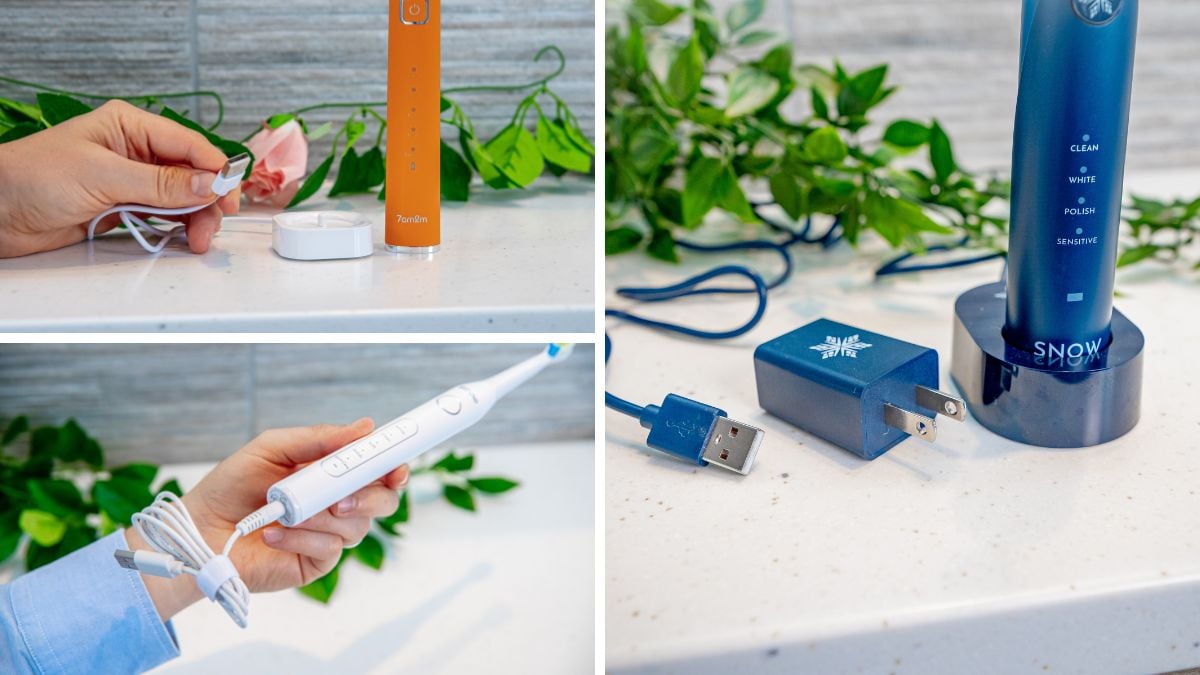
Some brushes can be charged in the travel case they are supplied with, which can add another option and more flexibility. SURI, as an example, is charged via USB Type-C. It can be charged within its case, using the same cable that charges many Android phones and the latest iPhone 15. We’ve found this to be a convenient way to charge the brush, especially as it only needs charging every few weeks.
A travel case is a useful accessory
In our experience the most useful extras to be supplied with a toothbrush are additional heads and a travel case.
Brush head stands and storage compartments can be convenient if you share a toothbrush with others, but are far from essential.
You don’t need to be a regular traveller to benefit from a case. Even if you occasionally go away for a night or two, a case protects the bristles from damage and dirt. Not to mention preventing other things in your wash bag from getting wet. It can also prevent that awkward buzzing sound in your luggage as you pass through customs!
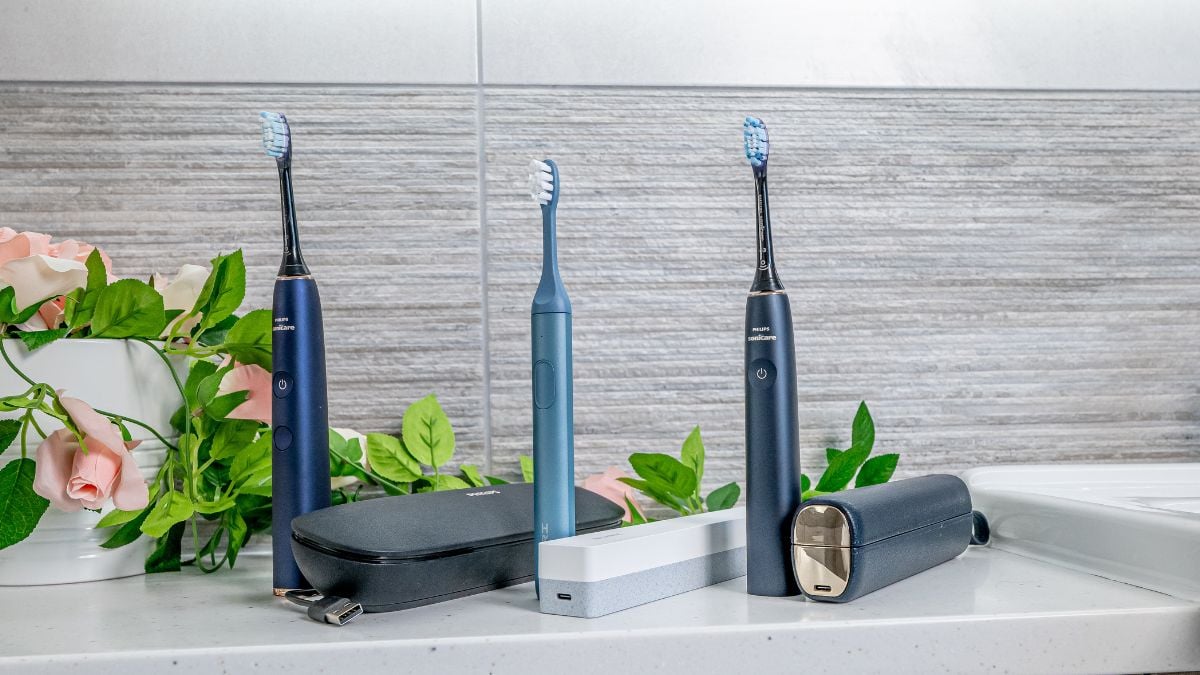
It’s well worth spending an extra $5-10 if you can afford it to get a case included. It’s harder to buy official cases afterwards. Third party cases serve a purpose but tend not to be as good.
Jon found a travel case useful during his recent Invisalign treatment. He was having to brush more regularly, often away from home, and having a case made things more convenient.
For those always on the go, charging travel cases are great. SURI’s is particularly slim and uses the same charger as most phones. Oral-B’s charging case is less convenient as it requires a bulky proprietary power adapter.
Things to consider if you’ve got dexterity issues
The majority of toothbrushes have a clean and minimal look with minimal textured surfaces for gripping onto.
Oral-B’s Smart and Genius models use different materials and textures to aid with grip. Although slimmer, the Philips One has a really textured handle, which makes it easy to grip. The Hydrosonic Pro from Curaprox is all smooth plastic, but the squarer design really helps with grip.
Aftermarket add-ons do exist but none are particularly pretty and do look like an add-on.
The vast majority of brush heads are pushed onto a brush handle to attach and pulled off to remove. Few require twisting or locking into place. You don’t typically need lots of force to attach or remove them.
We’ve found that SURI brush heads are some of the tightest fitting and can at times require an extra firm grasp to pull them off. This might be tricky if you struggle to grip or have limited strength in your joints.
Power buttons are something to consider too. Colgate’s Smart Hum and Hum Rhythm are 2 examples that we've found to have firmer buttons than other brushes and make for a less enjoyable user experience.
Many brands have money back guarantees, so you can buy online, try and return if they don’t work for you.
More detail: our electric toothbrush reviews
In order to gather the advice and recommendations above, we've extensively tested and compared a wide range of electric toothbrushes. For the vast majority of brushes we test, we either complete a written review, a video review, or both.
In the sections below we've grouped our written reviews. You can see our video reviews and comparisons on our YouTube channel.
Sonicare
- Philips Sonicare DiamondClean Smart review
- Philips One By Sonicare review
- Philips Sonicare ExpertClean review
- Philips Sonicare ProtectiveClean 4500 review
- Philips Sonicare DiamondClean 9000 review
- Philips Sonicare ProtectiveClean 6100 review
- Philips Sonicare 4100 Series review
- Philips Sonicare DiamondClean 9900 Prestige review
- Philips Sonicare 2100 Series review
- Philips Sonicare 3100 Series review
Oral-B
- Oral-B Pro 6000 review
- Oral-B Smart 3000 review
- Oral-B Smart 2000 review
- Oral-B Pro 1000 review
- Oral-B iO9 review
- Oral-B Pro 500+ review





